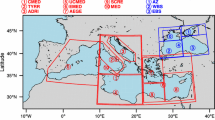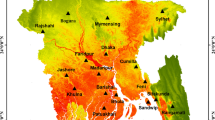Abstract
Human and natural physical-caused climate variation can affect climate extremes, also called maximum high temperature. The change of the inter-annual maximum temperatures has been studied between1981 to 2016. Annual Maximum Temperatures (AMT) data consists of the temperature study of 36 years. The analysis of the correlation between the Badin, Karachi, Quetta, Lahore, and Peshawar, Islamabad temperature data and the explanatory variable such as Global Annual Mean-Land-Ocean Temperature Index (GAMLOTI), annual carbon dioxide (ACD), and North Atlantic Oscillation (NAO) teleconnection arrangement in annual maximum temperature indicated between explanatory variable is significant. Therefore, the correlation between the Badin (AMT) and the GAMLOTI is significant with the relationship of correlation coefficient 0.127 at the level of significance 0.05, and the index of NAO is negative significant correlation (r =−0.151), and the correlation between Islamabad and Karachi’s annual maximum temperature and the explanatory variable is insignificant. The results of multiple regression analysis showed that the whole effect of global annual change means land-ocean temperature index GAMLOTI, the annual concentration of atmospheric carbon dioxide ACD, and the north Atlantic oscillation NAO index on the temporal variabilities of Badin, Quetta, Islamabad, Karachi, and Peshawar during the 36-year period. The variations occur R2 45.7%, 51.3%, 43.1%, 46%, and 48.1%. The relationship between the AMT and the GAMLOTI and the annual concentration of ACD represent the global warming, mostly effects on the variability of AMT.





Similar content being viewed by others
References
Ahmad I, Abbas A, Saghir A, Fawad M (2016) Finding probability distributions for annual daily maximum rainfall in Pakistan using linear moments and variants. Pol. J. Environ. Stud 25:925–937
Ahmed K, Shahid S, Chung E-S, Ismail T, Wang X-J (2017) Spatial distribution of secular trends in annual and seasonal precipitation over Pakistan. Climate Research 74:95–107
Bani-Domi M (2005) Trend analysis of temperatures and precipitation in Jordan. Umm Al-Qura University Journal of Educational, Social Sciences & Humanities 17:15–36
Bobée B, Perreault L, Ashkar F (1993) Two kinds of moment ratio diagrams and their applications in hydrology. Stochastic Hydrology and Hydraulics 7:41–65
Bonaduce A, Pinardi N, Oddo P, Spada G, Larnicol G (2016) Sea-level variability in the Mediterranean Sea from altimetry and tide gauges. Climate Dynamics 47:2851–2866
Bonfils S (2012) Trend analysis of the mean annual temperature in Rwanda during the last fifty two years. J Environ Protect 2012
Bozyurt O, Özdemir MA (2014) The relations between north Atlantic oscillation and minimum temperature in Turkey. Procedia-Social and Behavioral Sciences 120:532–537
Diaz HF, Giambelluca TW, Eischeid JK (2011) Changes in the vertical profiles of mean temperature and humidity in the Hawaiian Islands. Global and Planetary Change 77:21–25
Folland CK, Karl T, Vinnikov KY (1990) Observed climate variations and change. Climate change: the IPCC scientific assessment 195:238
Ghausi SA, Ghosh S (2020) Diametrically opposite scaling of extreme precipitation and streamflow to temperature in South and Central Asia. Geophysical Research Letters 47:e2020GL089386
Greenough G, Mcgeehin M, Bernard SM, Trtanj J, Riad J, Engelberg D (2001) The potential impacts of climate variability and change on health impacts of extreme weather events in the United States. Environmental health perspectives 109:191–198
Hamed KH (2008) Trend detection in hydrologic data: the Mann–Kendall trend test under the scaling hypothesis. Journal of Hydrology 349:350–363
Iqbal M, Eitzinger J, Formayer H, Hassan A, Heng L (2011) A simulation study for assessing yield optimization and potential for water reduction for summer-sown maize under different climate change scenarios. The Journal of Agricultural Science 149:129–143
Jeong JH, Ho CH (2005) Changes in occurrence of cold surges over East Asia in association with Arctic Oscillation. Geophysical Research Letters 32
Jones P, Osborn T, Briffa K, Folland C, Horton E, Alexander L, Parker D, Rayner N (2001) Adjusting for sampling density in grid box land and ocean surface temperature time series. Journal of Geophysical Research: Atmospheres 106:3371–3380
Karpouzos D, Kavalieratou S, Babajimopoulos C (2010) Trend analysis of precipitation data in Pieria Region (Greece). European Water 30:30–40
Khan N, Shahid S, Bin Ismail T, Wang X-J (2019) Spatial distribution of unidirectional trends in temperature and temperature extremes in Pakistan. Theoretical and Applied Climatology 136:899–913
Kolvir HR, Madadi A, Safarianzengir V, Sobhani B (2020) Monitoring and analysis of the effects of atmospheric temperature and heat extreme of the environment on human health in Central Iran, located in southwest Asia. Air Quality, Atmosphere & Health 13:1179–1191
Lehnert EA, Wilt G, Flanagan B, Hallisey E (2020) Spatial exploration of the CDC’s social vulnerability index and heat-related health outcomes in Georgia. International journal of disaster risk reduction 46:101517
Mann HB, Whitney DR (1947) On a test of whether one of two random variables is stochastically larger than the other. The annals of mathematical statistics 18:50–60
Mauget S (2011) Time series analysis based on running Mann-Whitney Z Statistics. Journal of Time Series Analysis 32:47–53
Mohsenipour M, Shahid S, Chung E-S, Wang X-J (2018) Changing pattern of droughts during cropping seasons of Bangladesh. Water resources management 32:1555–1568
Naghettini M (2017) Fundamentals of statistical hydrology. Springer
Nezhad EF, Ghalhari GF, Bayatani F (2019) Forecasting maximum seasonal temperature using artificial neural networks “Tehran case study”. Asia-Pacific Journal of Atmospheric Sciences 55:145–153
Peng D, Zhou T, Zhang L, Zou L (2019) Detecting human influence on the temperature changes in Central Asia. Climate Dynamics 53:4553–4568
Poudel A, Cuo L, Ding J, Gyawali AR (2020) Spatio-temporal variability of the annual and monthly extreme temperature indices in Nepal. International Journal of Climatology 40:4956–4977
Rahimi YG, Ahmadi M (2015) Statistical analysis and temporal trend of annual maximum temperatures of Abadan in Southwestern of Iran. Arabian Journal of Geosciences 8:8219–8228
Rohat G, Flacke J, Dosio A, Pedde S, Dao H, VAN Maarseveen M (2019) Influence of changes in socioeconomic and climatic conditions on future heat-related health challenges in Europe. Global and planetary change 172:45–59
Sadiq N, Qureshi MS (2010) Climatic variability and linear trend models for the five major cities of Pakistan. Journal of Geography and Geology 2:83
Schmidt GA, Shindell DT, Tsigaridis K (2014) Reconciling warming trends. Nature Geoscience 7:158–160
Shiru MS, Shahid S, Alias N, Chung E-S (2018) Trend analysis of droughts during crop growing seasons of Nigeria. Sustainability 10:871
Sillmann J, Roeckner E (2008) Indices for extreme events in projections of anthropogenic climate change. Climatic Change 86:83–104
Singh C, Ganguly D, Dash S (2017) Dust load and rainfall characteristics and their relationship over the South Asian monsoon region under various warming scenarios. Journal of Geophysical Research: Atmospheres 122:7896–7921
Singh C, Ganguly D, Sharma P, Mishra S (2019) Climate response of the south Asian monsoon system to West Asia, Tibetan Plateau and local dust emissions. Climate Dynamics 53:6245–6264
Solomon, S., Qin, D., Manning, M., Chen, Z., Marquis, M., Averyt, K., Tignor, M. & Miller, H. 2007. Summary for policymakers. Climate change 2007: the physical science basis. Contribution of Working Group I to the Fourth Assessment Report of the Intergovernmental Panel on Climate Change, 1-18.
Wald A, Wolfowitz J (1943) An exact test for randomness in the non-parametric case based on serial correlation. The Annals of Mathematical Statistics 14:378–388
Wu X, Guo W, Liu H, Li X, Peng C, Allen CD, Zhang C, Wang P, Pei T, Ma Y (2019) Exposures to temperature beyond threshold disproportionately reduce vegetation growth in the northern hemisphere. National Science Review 6:786–795
Yang X, Xu L, Liu K, Li C, Hu J, Xia X (2012) Trends in temperature and precipitation in the Zhangweinan River Basin during the last 53 years. Procedia Environmental Sciences 13:1966–1974
Yeung JK (2012) Summertime convective rainfall in the New York City-New Jersey metropolitan region. Princeton University
Yu Y, Mainuddin M, Maniruzzaman M, Mandal U, Sarangi S (2019) Rainfall and temperature characteristics in the coastal zones of Bangladesh and West Bengal, India. Journal of the Indian Society of Coastal Agricultural Research 37:12–23
Yule, G. U. & Kendall, M. 1950. An introduction to the theory of statistics, Charles Griffin and Co., Ltd. London. GENERAL INDEX AND INDEX OF SYMBOLS.
Zhu X, Wei Z, Dong W, Ji Z, Wen X, Zheng Z, Yan D, Chen D (2020) Dynamical downscaling simulation and projection for mean and extreme temperature and precipitation over central Asia. Climate Dynamics:1–28
Acknowledgements
We thank our respected reviewers and especially Yejuan Wang for their valuable comments and suggestions that helped us to improve this paper.
Author information
Authors and Affiliations
Corresponding author
Ethics declarations
Conflict of interest
The authors declare no competing interests.
Additional information
Responsible Editor: Zhihua Zhang
Rights and permissions
About this article
Cite this article
Khan, T., Wang, Y., Yuan, N. et al. Statistical analysis and temporal trend of annual maximum temperature with teleconnection patterns of different stations in Pakistan. Arab J Geosci 14, 1458 (2021). https://doi.org/10.1007/s12517-021-07834-5
Received:
Accepted:
Published:
DOI: https://doi.org/10.1007/s12517-021-07834-5




